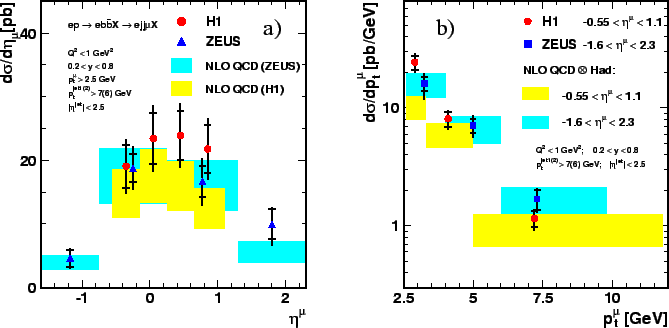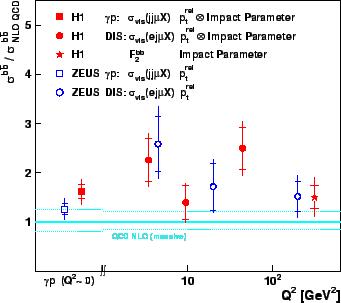Figure 32 shows the differential
photoproduction cross-sections as a function of the muon pseudo-rapidity
for the process
![]() jet
jet![]() jet
jet![]() .
The H1 [44] and ZEUS [40] data,
which are in reasonable agreement, are compared
to NLO calculations in the massive
scheme[80]. The same scales and parton density distributions
are used in both analyses.
While the ZEUS data are well described by the theory,
the H1 data at low transverse momenta
are observed to be somewhat higher than the
expectations.
The errors of the theory prediction are dominated by the uncertainties
of the renormalization scale and the
.
The H1 [44] and ZEUS [40] data,
which are in reasonable agreement, are compared
to NLO calculations in the massive
scheme[80]. The same scales and parton density distributions
are used in both analyses.
While the ZEUS data are well described by the theory,
the H1 data at low transverse momenta
are observed to be somewhat higher than the
expectations.
The errors of the theory prediction are dominated by the uncertainties
of the renormalization scale and the ![]() quark mass.
In the calculations different parameter choices,
e.g.for the modeling of the hadronization and decay of the
quark mass.
In the calculations different parameter choices,
e.g.for the modeling of the hadronization and decay of the ![]() hadron,
lead to variations of the prediction of up to
hadron,
lead to variations of the prediction of up to ![]() .
.
 |
 |
ZEUS [41] and H1 [44] have also measured
the jet-muon beauty cross section in DIS events
with at least one hard jet in the Breit frame,
![]() GeV,
together with a muon for photon virtualities
GeV,
together with a muon for photon virtualities ![]() GeV
GeV![]() .
The measurements from H1 and ZEUS are performed in slightly different
kinematic regions (see table 3).
Comparisons of the data with the NLO QCD calculation
in the massive scheme [81] show that the data are higher than the
predictions by about 2 standard deviations.
.
The measurements from H1 and ZEUS are performed in slightly different
kinematic regions (see table 3).
Comparisons of the data with the NLO QCD calculation
in the massive scheme [81] show that the data are higher than the
predictions by about 2 standard deviations.
The results of the beauty measurements with jets and muons at HERA
are summarized in fig.33 where
the ratios between the measured
beauty production cross sections and the corresponding
next-to-leading order predictions in the massive
scheme [80,81]
are shown as a function of the photon virtuality ![]() .
The data tend to be somewhat higher than the predictions
but still in agreement.
.
The data tend to be somewhat higher than the predictions
but still in agreement.
In earlier measurements [36,39] NLO QCD
predictions were used to extrapolate the measured visible
cross sections for dijet events with a lepton
to more inclusive ![]() or b-quark production cross sections.
In these measurements softer jet and muon cuts were used in order
to overcome statistical limitations.
In [40] ZEUS extracted
the
or b-quark production cross sections.
In these measurements softer jet and muon cuts were used in order
to overcome statistical limitations.
In [40] ZEUS extracted
the ![]() quark differential cross section as a
function of the quark transverse momentum for a
quark differential cross section as a
function of the quark transverse momentum for a ![]() quark
pseudo-rapidity range in the laboratory frame
quark
pseudo-rapidity range in the laboratory frame
![]() and the result was found to be consistent with the
previous ZEUS result from semi-leptonic
and the result was found to be consistent with the
previous ZEUS result from semi-leptonic ![]() decays into
electrons [39], translated into the
decays into
electrons [39], translated into the ![]() quark
cross section for
quark
cross section for ![]() GeV and
GeV and ![]() and also with the most recent
results.
In a previous measurement by H1 [36]
the inclusive
and also with the most recent
results.
In a previous measurement by H1 [36]
the inclusive
![]() cross
section was found to be
cross
section was found to be ![]() standard deviations higher
than the new measurement [44] when extrapolated into the same
kinematic range using the same model assumptions.
In this early measurement the cuts on the jet and muon
transverse momenta were comparably loose (see table 3).
It can be concluded that the difference between this measurement
and the later measurements is not due to extrapolation effects,
as suggested e.g.in [162,163],
but mainly results from experimental
effects which may occur when going to small values of
standard deviations higher
than the new measurement [44] when extrapolated into the same
kinematic range using the same model assumptions.
In this early measurement the cuts on the jet and muon
transverse momenta were comparably loose (see table 3).
It can be concluded that the difference between this measurement
and the later measurements is not due to extrapolation effects,
as suggested e.g.in [162,163],
but mainly results from experimental
effects which may occur when going to small values of ![]() of the
of the ![]() -quark.
Similar excesses of the cross section above expectation
appear to be visible in other measurements of the beauty cross sections
which probe the region of small
-quark.
Similar excesses of the cross section above expectation
appear to be visible in other measurements of the beauty cross sections
which probe the region of small ![]() of the beauty quark
(see sections 6.3.1 and 6.3.2).
of the beauty quark
(see sections 6.3.1 and 6.3.2).